Finitary relation
A relation (Latin relatio "relation", "relationship") is generally a relationship that can exist between things. Relations in the sense of mathematics are exclusively those relationships for which it is always clear whether they exist or not; objects cannot therefore be in a relation to each other "to a certain degree". Thus, a simple set-theoretical definition of the term is possible: A relation 




Unless explicitly stated otherwise, a relation is commonly understood to be a two-digit or binary relation. In such a relation, two elements 










Important special cases, for example equivalence relations and order relations, are relations on a set.
Today, some authors do not necessarily consider the term relation to be restricted to sets, but allow any class consisting of ordered pairs to be considered a relation.
Definitions
Two-digit relation
A two-digit relation 



The set 


Sometimes, however, this definition is not precise enough and one includes the source and target set in the definition, the above subset is then called the graph 



The knowledge of source and target set is particularly important when functions are considered as special (so-called functional) relations.
The primal, argument or definition or pre-region of a given two-digit relation 



In this sense, the value set, value or image or after-range denotes the smallest after-range to 



Occasionally, the term field (or node set) is used for the union set, in characters

In addition, the following designations can be found:
- Domain
either for the (in principle arbitrarily large) source set or for the original image set (defined by the graph),
- Co-domain (English codomain, range)
either for the target set or for the image set,
- Node set (
) for the field of a relation.
If two relations match in their graphs, they are also said to be essentially the same.
Example: Any relation 


n-digit relation
More generally, an 




Here 

The more detailed definition can also be generalised to 



The sets 


The field of an 

Substantial equality is defined analogously as for two-digit relations by correspondence of the graphs, in particular every }



One-digit and zero-digit relation
A one-digit relation on a set 



The zero-digit relations are therefore the subsets of the empty Cartesian product 





Relations between or on real classes
Often the carrier areas 



A two-digit class relation 












Explanations and spellings
The Cartesian product of two sets 
















Relations and functions
- A function
is a special, namely a left-stotal and right-unique (two-digit) relation, for more details see below.
- A multifunction
is a left-total relation
.
- A partial function
is a (generally non-left-total) right-unique relation
.
In all cases, 

The following applies to functions and multifunctions:
In the more detailed definition 



The following applies to functions and partial functions:
For 



In general:
- The zero-digit relations
(as zero-digit null relations) and
(as a zero-digit full relation) have as characteristic functions the Boolean or logical constants
and
, as always for zero relation and all relation.
- The case of single-digit relations is trivial.
- relation
(or
) corresponds uniquely to a truth function χ
. This function is also known as the indicator function or characteristic function of the subset
(or
), where
can be replaced by
- An
-digit relation
(or
) corresponds to the characteristic function χ
It applies:
.


- relation
also be understood as a mapping κ
from
into the power set of
κ
one then often speaks of a correspondence, and for
transition relation.
Concatenation of relations
The forward concatenation of two two-digit relations 
Chaining in the reverse order is called backward chaining:

Some authors (W. v. O. Quine) use the notation 
The sequence is the same for backward chaining as for chaining functions (which can be understood as special relations).
The concatenation of two-digit relations is also called a relative product. In the case of concatenation, the simplest relation, the empty relation contained in every Cartesian product, can also occur. 



Example: The relation "being sister-in-law of" is the union set
- of the relative product of the relation "being a brother of" and the relation "being a wife of" and
- of the relative product of the relation "being a spouse of" and the relation "being a sister of".
Reverse relation
The inverse relation (also called converse relation, converse or inverse relation) is 

Occasionally, this is also called a transposed relation, in characters 
- Example 1: The inverse relation of the relation "is descendant of" is the relation "is ancestor of".
- Example 2: The inverse relation of the relation "is less than" is the relation "is greater than".
- Example 3: The inverse relation of the relation "delivers to" is the relation "is delivered by".
The generalisation of the inverse relation (converse) to 

- the interchanges of only 2 coordinates (transpositions) and
- the inversion of the sequence (mirroring),
both examples of (cyclic) self-inverse permutations.
Let π 







Image and archetype
Given a two-digit relation 


The archetype of a set or class 

Occasionally, the designation 
![{\displaystyle R[Y]}](https://www.alegsaonline.com/image/c9ca7f0a1fdfe689def5adb90032f7da6c9ffc93.svg)


![{\displaystyle R[a]}](https://www.alegsaonline.com/image/33ac134e157437a3986ad725151bf8e5fe566156.svg)
![{\displaystyle [a]_{R}=R\langle \{a\}\rangle =R^{-1}\langle \{a\}\rangle }](https://www.alegsaonline.com/image/6bc947079ddacce3198f75fca059a2f3ad5e4332.svg)
Restriction
Relations can be restricted in various ways to subsets of the carrier sets, for more information see Restriction of a relation.
Complementary relation
For two-digit relations 


analogously for 





If the complex notation is used as a basis, then

where 

As for all sets, the complement is also involutive for relations:

Homogeneous relations
If 



Special homogeneous relations and operations on homogeneous relations
A special homogeneous relation in a set 
Alternative notations for the diagonal are Δ 





Another special homogeneous relation is the all relation or universal relation


If 
The all-relation plays a role in graph theory (see below). An example of its application is the following theorem:
If 




The formation of the reverse relation (converse relation) of a homogeneous two-digit relation yields again a homogeneous two-digit relation (closedness), twice execution yields again the initial relation (involutivity). The connection of any (also non-homogeneous) relation with its converse relation is symmetrical and reflexive, i.e. an equivalence relation, but generally not equal to the identity relation.
In the case of a homogeneous relation the concatenation 









Extending the notation instead of


Thus, any integers 
Moreover, every monoid of homogeneous relations with the empty relation (zero relation) has
nor an absorbent element.
By uniting the different powers, the following relations arise


Algebraic structures
All together, the two-digit relations on a set 
Using the notations 
Together with the constraints, the homogeneous relations form a (heterogeneous) Peirce algebra.
Homogeneous multi-digit relations
Homogeneous multi-digit relations are (with their graph) subsets of 






The application of permutations to their 


Graph theory and generalisations
→ Main article: Graph theory
Graph theory describes sets with a relation on them together with certain generalisations under a common umbrella term, the graph. The cases considered in graph theory are usually finite (unless otherwise stated).
A relational structure 






2. symmetric graphs 







3. further generalisations concern so-called directed graphs with grouped multiple edges, where each edge has a natural number as multiplicity. The edges of such graphs can be represented by a multiset 





4. weighted nodes and/or edges: We speak of weights instead of colours if the mapping 
![{\displaystyle f\colon \;M\to [0,1]}](https://www.alegsaonline.com/image/981c1ffde3d83759978efcfb0871056111d361cd.svg)



Examples
· 
All possible ordered pairs 




· 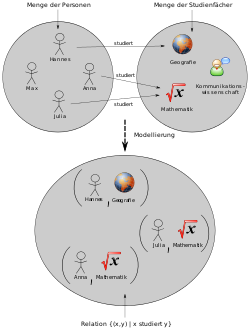
Example of a relation "A person x studies subject y".
· 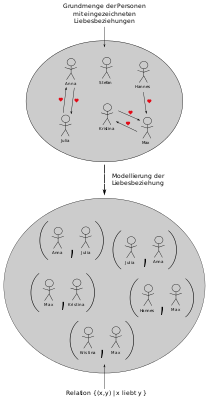
Example of a relation "person x loves person y". This two-digit relation is modelled over a set of ordered pairs.
· 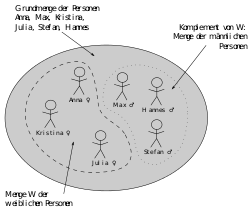
The one-digit relation "person x is female" is modelled as a subset of the basic set.
· 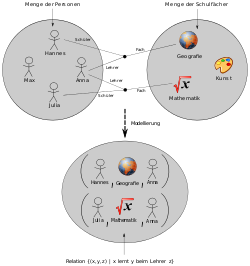
The three-digit relation "Person x learns subject y from teacher z" is realised via a set of 3-tuples.
Properties of two-digit relations
General relations
Overview of the properties
The following relations are important for functions (represented as special relations). In general, the relation exists here 


| The relation | exactly when (predicate logic) | or equivalent (quantity notation) | and that means: |
| left total or definal | | | Each element from |
| right-total or surjective | | | Each element from |
| left unambiguous or injective | | | Each element from |
| (right-) unique | | | Each element from |
| The relation | exactly when (predicate logic) | or equivalent (quantity notation) | and that means: |
| bitotal | | | Every element from |
| one-to-one | | | Each element from |
| bijective | | | Each element from |
| Illustration or function | | | Each element from |
Alternative ways of speaking
![]()
This article or section needs revision. More details should be given on the discussion page. Please help improve it and then remove this marker.
One also says
- left-complete in place of left-total,
- right-complete in place of right-total,
- preambiguous in place of leftambiguous,
- post-unambiguous in place of right-unambiguous,
A right unambiguous or functional relation is also called a partial function. If it is also left-total - i.e. a function - then it is also called a total function for clarification.
Functions
Overview of functional properties for relations
A relation is therefore a (total) function if it is left-total and right-unique. This means that every element in A has exactly one partner in B. The properties surjective, injective and bijective are usually used for functions and specify certain additional properties. For example, a function (and also any relation) 

| The relation | exactly when they have a | is or equivalent (quantity notation) | and that means: |
| Surjection | surjective function | | Each element from |
| Injection | injective function | | Each element from |
| Bijection | bijective function | | Each element from |
Reverse function
A mapping or function is also called
- reversible uniquely or reversible if it is bijective.
A function is always invertible as a relation, but as a function it is invertible exactly when its inverse relation is also a function, i.e. when there is an inverse function of it.
Homogeneous relations
The examples given in the following tables refer to the ordinary arrangement of real numbers when using the equals sign "=", the less-than sign "<" and the less-than-equal sign "≤".
| The relation | exactly when (predicate logic) | or equivalent (quantity notation) | and that means: |
| Right-comparative or third-comparative | | | If two elements are each related to an identical third element, then they are also related to each other. E.g. with |
| left-hand comparative or Euclidean | | | If a first element is related to a second and a third element, these are also related to each other. For example, with |
| transitive | | | If a first element is related to a second element and this in turn to a third element, the first element is also related to the third element. For example, |
| intransitive | | | If two elements are in relation and, in addition, the second element is in relation to a third element, then the first element is not in relation to the third element. For example, any natural number is |
Non-transitivity (i.e. the relation is not transitive), intransitivity and negative transitivity are each different from each other.
| The relation | exactly when (predicate logic) | or equivalent (quantity notation) | and that means: |
| reflexive | | | Each element is in relation to itself, e.g. |
| | |||
| irreflexive | | | No element is in relation to itself, e.g. applies to |
| The relation | exactly when (predicate logic) | or equivalent (quantity notation) | and that means: |
| symmetrical | | | The relation is undirected, e.g. from |
| | |||
| antisymmetrical or identitive | | | There are no two different elements that are related in both directions, e.g. it |
| asymmetric | | | There are no two elements that are related in both directions, e.g. it follows from |
| The relation | exactly when (predicate logic) | or equivalent (quantity notation) | and that means: |
| total or complete | | | Two elements each are in relation, e.g. if |
| Connected | | | Two different elements are related, e.g. if |
| trichotome | | | Two different elements are always related in exactly one way, e.g. if either |
The following relationships apply between the properties:
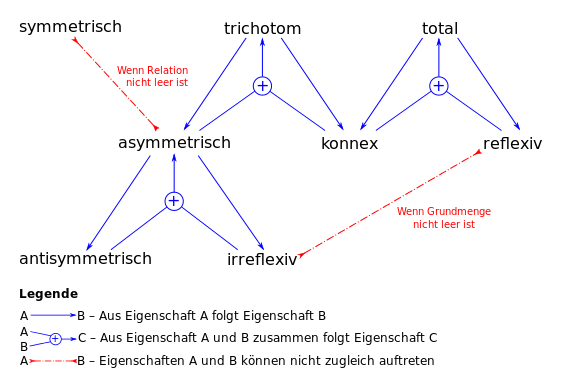
The following relationships exist between the properties of a relation 
is reflexive
is irreflexive (and vice versa).
is symmetrical
is symmetrical.
is antisymmetric
is connex (and vice versa).
is total
is asymmetric (and vice versa).
Relation classes
Other important classes of relations and their properties:
- Quasi-order or pre-order: transitive and reflexive
- Compatibility relation or tolerance relation: compatible (reflexive and symmetrical) (English: in the finite case dependency relation, in the transfinite case tolerance relation).
- Equivalence relation: transitive, reflexive and symmetrical
- Half-order/partial order, partial order or order: transitive, reflexive and antisymmetrical.
- Full order/total order or linear order: transitive, reflexive, antisymmetrical and total
- Well-ordering: a linear ordering in which every non-empty subset of A has a smallest element.
- Strict order or strict half order/partial order: transitive, irreflexive and antisymmetrical (i.e. asymmetrical)
- Strict full order/total order or linear strict order: transitive, irreflexive, antisymmetrical and connective
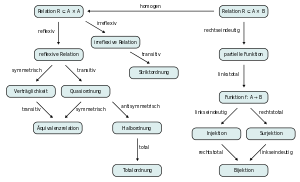
Relationships between different two-digit relations
Relation sign
In elementary mathematics there are three basic comparative relations:
(Example:
is smaller than 3")
(Example:
"3 is equal to 3")
(Example:
is greater than 2")
with 
Two real numbers always stand in exactly one of these relations to each other. These relation signs can also be used to form others. The following applies:
if
= y
(Example:
"4 is not greater than 5")
if
= y
(Example:
"5 is not less than 5")
if
> y
(Example:
"4 is not equal to 5")
for all 
The above order relations do not exist for complex numbers.
Mathematicians also use the sign ≤ for abstract order relations (and ≥ for the associated inverse relation) while "<" is not an order relation in the sense of the mathematical definition.
For equivalence relations, "symmetrical" symbols such as ≈, ~, ≡ are preferred.
Category theory
For any half-ring 



.
- A morphism
is a function
.
- For objects following applies
This is identical to the Kronecker : 
- For objects
and morphisms
holds.

The morphisms are thus set-indexed matrices and their composition occurs as in matrix multiplication, 

In the special case 


Application
Operations on whole relations are studied in relational algebra. In computer science, relations are important when working with relational databases.
See also
- Congruence relation
- Predicate (logic)
Search within the encyclopedia












































































